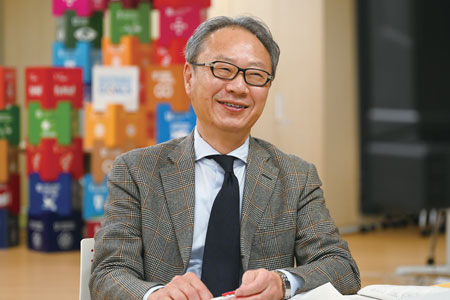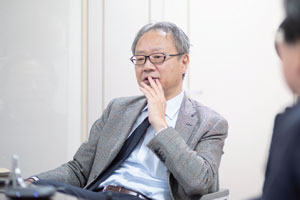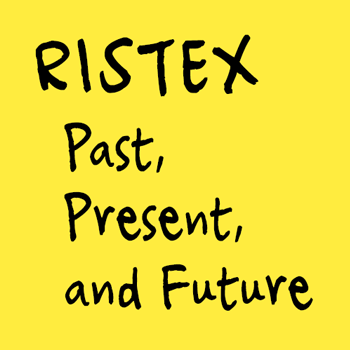
Director-General, RISTEX
KOBAYASHI Tadashi
PROFILE
KOBAYASHI Tadashi served as a professor and the Executive Vice President of Osaka University, and is currently a specially appointed professor at Center for the Study of Co*Design in Osaka University. At RISTEX, he served as a senior fellow before becoming appointed as the Director-General. He was also the first president of the Japanese Society for Science and Technology Studies. He is currently a member and a Secretary of the First Section of the Science Council of Japan. His publications include Who Are to Consider Science and Technology?: An Experiment of Consensus Conference, 2004, and The Age of Trans-Science, 2007 (both in Japanese).
Background of the Concept 'S&T for Society (STfS)' and Convergence of Knowledge (総合知)
STfS that RISTEX advocates has several historical contexts. One is post-Cold War academic discussions around the world regarding how science in the 21st century should be. With the collapse of the Cold War, in which the uplifting of national prestige could be considered the raison d'être of science, the question of what science is for arose anew at the end of the 20th century. Against this background, the 'use' of science emerged as an enticing notion. The 1999 World Conference on Science adopted the Declaration on Science and the Use of Scientific Knowledge (Budapest Declaration), and the attempt to express the concept of 'use' in Japanese has led to the framing of problems and approach to solutions derived from engineering.
At that time, there was much discussion on future S&T policy after the merger of the Ministry of Education and the Science and Technology Agency planned as part of the reorganization of ministries in 2001. The topics discussed apparently stretched from research on safety and security, from which a Mission Program in RISTEX (System) probably stemmed, new mode of basic research, to social issue-driven research. I also hear that there was a suggestion to call such research 'public technology.' This term was not adopted in the end as it was likely to be associated with civil engineering, of which Japanese name literally means engineering of soil and wood. This Japanese translation was, in the first place, a desperate attempt to translate civil engineering, which implies how difficult it was to express 'civil' in Japanese. This in turn may indicate that the original meaning of civil engineering was in fact what current 社会技術 (STfS) is aiming to achieve. In any case, the term suggests that engineers who led those discussions then were firmly determined to transform what was conventional, be the cause of changes, and to solve problems.
Today we call ourselves 社会技術研究開発センター (the Center for Research in Science and Technology for Society) in Japanese, but the problem of terminology could not be resolved easily then, and it was even more difficult to decide its English name. After much consideration, 社会技術 was coined, and rather than a literal translation (social technology), "Science and Technology for Society" from the Budapest Declaration was adopted for its English name.
The R&D for solutions to social issues, which RISTEX has been promoting, does not have a fixed formula that specifies which knowledges to be combined. Rather, it is characteristic for its flexible style of promoting R&D, that is, identifying the goals to be achieved, or the purposes of R&D (missions that correspond to prominent social issues at that time, such as well-being, creation of social and public values and so on), working out the methodology and disciplines for achieving them, and assisting R&D accordingly. In this sense, the notion of 'using' S&T, which is increasingly more manifest in the 21st century, gave birth to the term 社会技術, and perhaps we could say 総合知 (convergence of knowledge), too, stems from the same idea.
A Turning Point in Academia and the Term 総合知 (Convergence of Knowledge)
Examining the Article 3 "Policy for the Promotion of the Creation of Science, Technology and Innovation" of the Science, Technology and Innovation Basic Law makes us realize why the term 'convergence of knowledge' is necessitated now. For instance, Item 5 of the Article states that "[the] creation of science, technology and innovation must be promoted with the aim of realizing a society in which all citizens can enjoy the full benefits of the creation of science, technology and innovation," and this clearly appears to have in mind the SDGs' principle of "leaving no one behind." Also, we notice the following statement in Item 6 which seems to serve as the basis for the concept of convergence of knowledge.
In promoting the creation of science, technology and innovation, attention must be paid so that appropriate measures are taken to address the following challenges and other social issues by converging knowledges on science and technology from all academic disciplines:
(i) challenges facing our country, including the declining birthrate and aging society, declining population, and responses to the development of cross-border socio-economic activities,
(ii) challenges facing humankind, including food problems, constraints in energy use, and global warming, and
(iii) new challenges in employment and other areas due to changes in socio-economic structures induced by application of S&T.
At present, there are words into which new meanings are infused such as 総合知(convergence of knowledge), intermingled with various existing words such as STfS, transdisciplinary research, and SSH integration. Such a situation appears to me as implying a change occurring in the relationship between academia and social issues, and thus academia facing a turning point. The notion of 'using' science was not explicit, and expressions such as 'science for knowledge' in the Budapest Declaration sufficed to convince the Mertonian view of science*1 probably until the 1970s, which then began to deteriorate, and this trend became more evident in the 1990s. We should also note that at the same time information science, of which nature is very different from conventional science, showed a rapid development.
Entering the 21st century, there was an increasing demand for science to contribute to solving social issues, and accordingly, the structure of funding began to change. We may say that science can no longer expect to receive support from society and politics merely by maintaining that freedom of research is important, in the classical sense. Meanwhile, academic disciplines became increasingly specialized, to an extent it is almost impossible to grasp the overall picture of scientific research, and on top of that, social issues so complex and grave have become harder to be addressed appropriately by such research. Considerations and attempts to supplement what is lacking resulted in the coinage of various terms but the 'something' they try to articulate has not yet crystallized enough, and thus, it seems, its manifold expressions are being tested and still coexist at present. We may consider STfS and the convergence of knowledge as examples of such 'something.'
Tracing the roots of this 'something' takes us back to terms that originate from medicine, such as 'transdisciplinarity' and 'evidence-based medicine,' which emerged around 1970 when the search for new wording to express novel concepts began. These terms signify the awareness that it was impossible to advance medicine without collaborative efforts among medical researchers who produce evidence-based knowledge; medical professionals who has enough clinical experience and use such knowledge; and also voices of patients, their families, and patient advocacy groups who receive the application of such knowledge. Medicine encompasses scientific aspects typified by physics as well as other aspects that transcend science. The 'use' of knowledge for the purpose of treatment is a fundamental nature of medicine, which cannot be reduced to a 'human biology.' Here again, the challenge lies in the use of knowledge. The idea of technology assessment, which comprehensively forecasts and analyzes the positive and negative effects of technologies also materialized around that time. This implies that there began to appear doubts to technocratic optimism that emphasizes the benefit of using science. As the 21st century drew closer, issues such as environmental problems that are beyond the scope of conventional discipline-based approaches became increasingly more recognized, and as a result initiatives such as Future Earth started to appear. Or we may say that medicine, which has a much longer history than science, provided a model, and we arrived at the analogy of diagnosing and treating the earth itself. Thence, environmental issues have prompted a drastic review of roles of academia.
Jane Lubchenco, an environmental scientist and marine ecologist, in a 1998 Science article entitled "Entering the Century of the Environment: A New Social Contract for Science" argued that "impacts of human activities on ecological systems are becoming too significant to ignore, and science needs to respond quickly to social changes caused as a result and other emerging challenges." She called for "all scientists to devote their energies and talents to the most pressing problems of the day," and she claimed that "new fundamental research, faster and more effective transmission of new and existing knowledge to decision-makers, and better communication of this knowledge to the public will all be required to meet this challenge." Her argument which is based on the global environmental issues, indicates fundamental perspectives in the consideration of how science and academia should be in the 21st century, as did the Budapest Declaration. In 2006, Jerome Ravetz asserted in his book The No-Nonsense Guide to Science that impacts on society of research that were rapidly progressing in developed countries such as those in the fields of genomics, the brain, artificial intelligence, nanotechnology, and neuroscience would become too significant to ignore, and that the need for discussions about ethical, legal and social issues (ELSI) and similar considerations would become increasingly more important. He called such a pursuit "SHEE science," the science of safety, health and the environment, plus ethics, and warned that S&T could run out of control unless these sciences are cultivated simultaneously. His suggestion of the acronym "SHEE" seems to contain certain gender-sensitive irony as SHEE stands for 'soft' sciences, as opposed to emerging hard sciences which are often associated with power.
So far, I have been writing from the perspective of the turning point in academia, but what about the social issues that academia is required to address? It seems there is a general awareness of the change in the nature of social issues we face, and attempts are being made to express these in various ways: 'trans-scientific' problems which "can be asked of science and yet which cannot be answered by science" alone; circumstances described as VUCA*2 which are unpredictable and intricate; 'wicked problems' that are vague and elusive, and thus have no clear solution; and 'systemic risk,' a financial term that refers to the impact of a malfunction in an individual system on another system or the whole. And to describe the research required to tackle these problems, expressions such as transdisciplinary research and SSH integration were proposed, and the academic community worldwide is discussing enthusiastically about its promotion.
Here again, global environmental issues are significantly important. And these are, in fact, much larger in scale than how they are generally understood in Japan as scientific knowledge of global warming is now a prerequisite for discussions in SSH. For example, research on community development and regional studies can no longer be conducted without considering global and environmental constraints. It is obvious that SSH is affected by questions such as what existing values we should change, and how we should rearrange social systems in order to respond to global environmental challenges. The SDGs is exactly a term that sums up this situation. Indeed, a tectonic shift is occurring slowly in academia, just as Lubchenco said that a new social contract was needed.
How do we express this situation, and how are we going to obtain solutions? Perhaps various terms are being coined from different disciplines and sectors because such questions are commonly shared, and all are aiming to reach the same goal. It is as if various people are trying to climb the same mountain from different trailheads. Some are climbing along an old trail of 'SSH integration,' others along a somewhat peculiar trail of 'transdisciplinarity' which is gaining more awareness recently. Yet others choose to climb along an old trail of 'convergence of knowledge' which has been recently renovated. Among them, RISTEX has been advocating STfS for 20 years, by establish a trailhead as well as the trail route. While there are multiple entrances, we should understand that all of these share the same aspiration and goal, consider how to reach the summit, and put it into practice - this, I think, is the most important thing that we should keep in mind.
*1 An understanding of science that assumes science as progressing without being influenced by various interests in society, and a pursuit of the truth by scientists who possess autonomy.
*2 An acronym for Volatility, Uncertainty, Complexity and Ambiguity. It refers to circumstances where the future is uncertain and difficult to predict. It was originally a military term but has been in the business vocabulary in recent years.
My Message at Present

S&T policy has shifted from S&T promotion to innovation policy, and has become more of a public policy now. There is a heightened awareness of social implementation, and thus during the revision of the Basic Law, the term 'innovation' became included. Innovation is not something that merely aims to create economic values. Rather, it originally refers to what creates new social values and systems and contributes to solving social issues, and that is probably why a key term such as 'convergence of knowledge' was suggested in the first place.
Then, RISTEX can be said to have arrived at a similar idea and has been putting it into practice from quite early on. Recent S&T policy has become more inclined towards innovation policy, or public policy, and the intention to use the R&D outputs to create economic and social values is increasingly apparent. Research is no longer completed in the laboratory as it used to be, transcends the academic boundary and becomes used in society. And what was impossible in the past is rapidly becoming feasible. This is particularly true for information and bio technologies.
While more things are rapidly becoming feasible, questions that need to be addressed are whether what really need to be implemented are feasible, and whether there are things that are feasible but should not be implemented. Without relying entirely on scientists, society as a whole needs to engage in these questions and for that, approaches from SSH is indispensable. Such efforts, which have been referred to as research in ELSI since the 1990s, require approaches that are interdisciplinary as well as transdisciplinary for these need to look into the use of knowledge, and thus such research is something that is accordant with RISTEX's philosophy. Researchers in S&T are required to take it as their obligation to consider what meaning the knowledge they produce have in society, while researchers of SSH should consider how to appropriately control the immense production of knowledge in S&T. These are examples of changes in academia that are required now.
Lastly, I would like to address how pure science in the conventional sense is going to be positioned in such a trend. From the viewpoint of pure scientists, there would be a criticism that the current trend places too much emphasis on S&T as a tool for innovation and social contribution. And they may assert that pure scientific thinking is essential as a foundation for S&T that can contribute to society, and thus a training for pure science is essential. Ultimately, we arrive at a fundamental question of whether S&T should be something useful, which imposes us to reconsider the freedom and responsibility of academic research. As to what should be questioned of science in the 21st century, would it not be how the era and society affect academic 'curiosity'? We may not need to assume that there is a mutually exclusive dichotomy between social contribution and researchers' curiosity. In the Dialogue #1, YOSHIKAWA Hiroyuki expressed that it was perfectly natural for us to have intellectual curiosity about issues of global environment and other social problems insofar as we live in modern society. Of course, it does not resolve every question related to pure science, but it is certainly an opinion worth listening attentively to.
| 20 Years of RISTEX / S&T for Society TOP >>> |  |